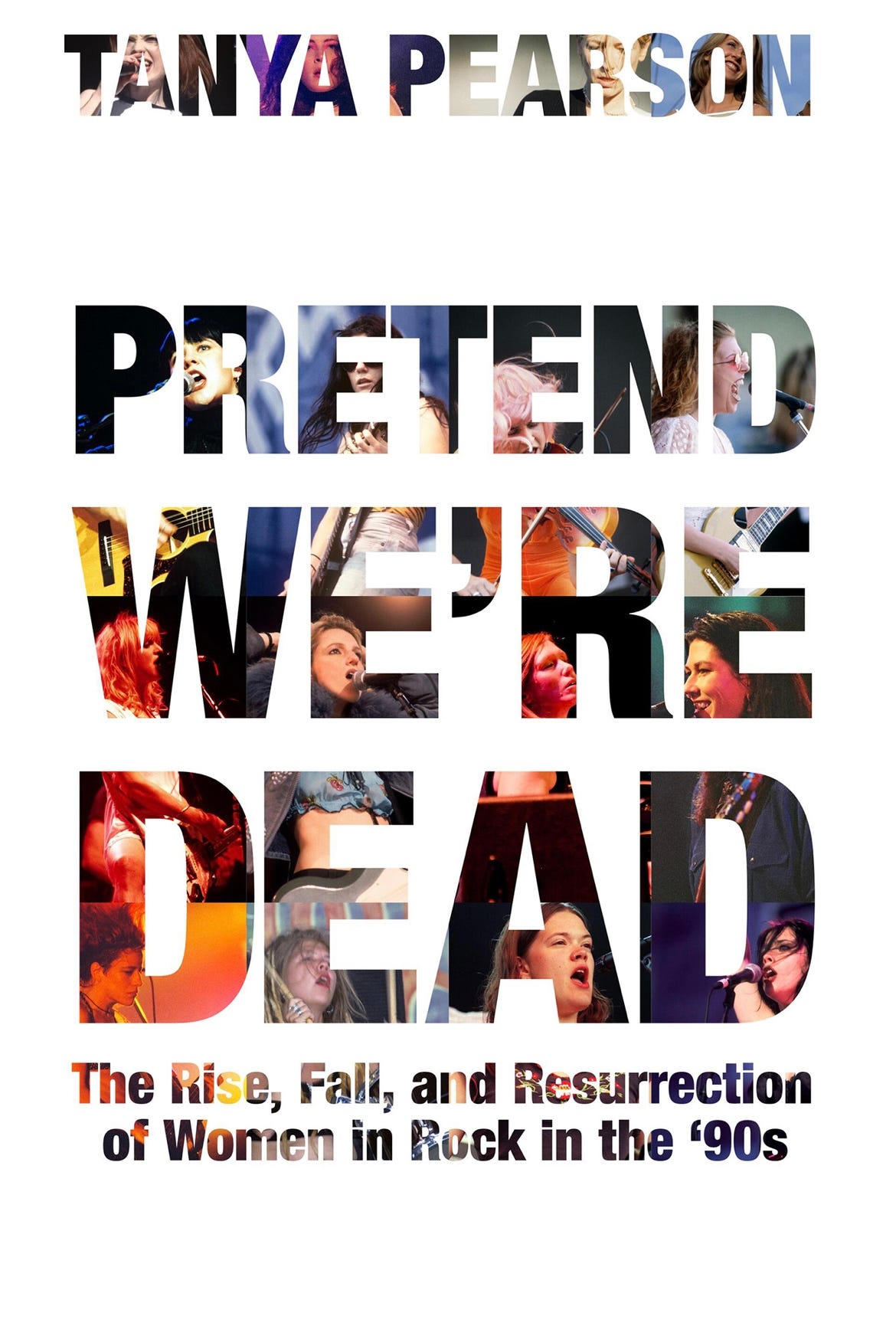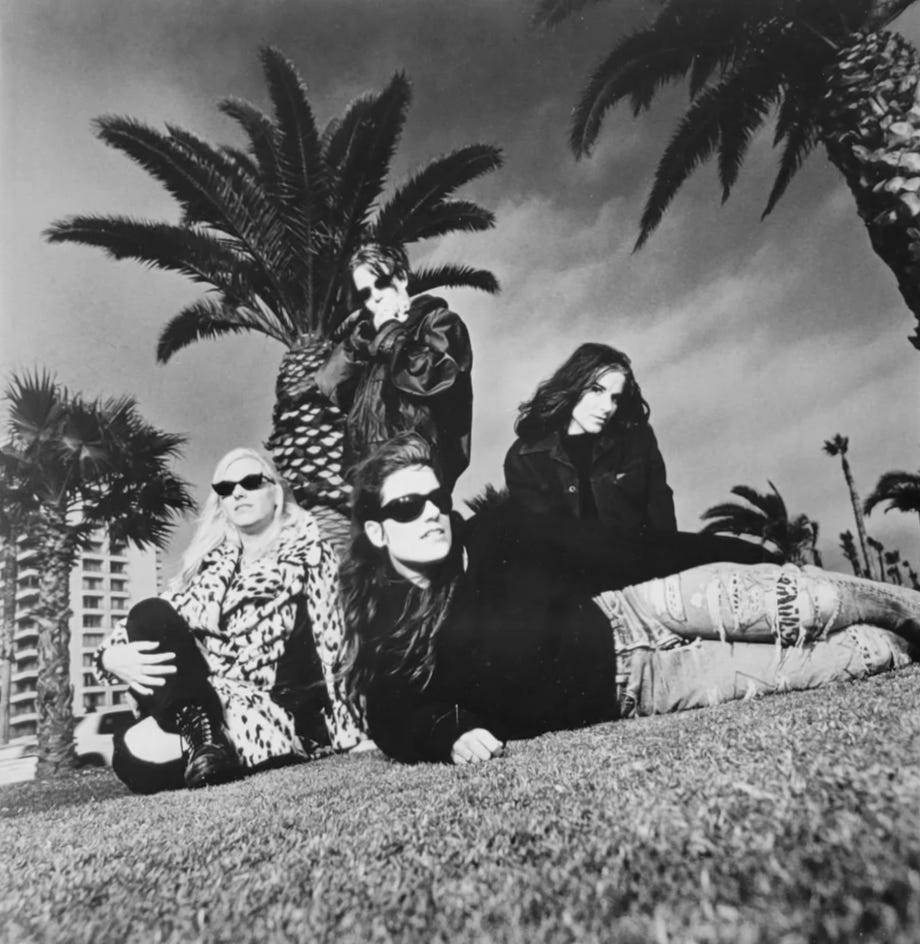Book Review: 'Pretend We're Dead – The Rise, Fall, and Resurrection of Women in Rock in the '90s'
From the founder of the Women of Rock Oral History Project, an exploration of women in the '90s rock scene, featuring original interviews
The ‘90s were thirty years ago, give or take a few months. What’s critically thinking induced though is, are you legacy or are you listenable?
Author Tanya Pearson raises all this and more in Pretend We’re Dead: The Rise, Fall and Resurrection of Women in Rock in the ‘90s quite succinctly. As Pearson has done so heroically with her Women in Rock: An Oral History Project, the role of female-driven music comes from many viewpoints. As we’ve moved ahead in so many ways — #MeToo, for example — we’re so far from where we could be. We feel overwhelmed by the ones who produce the most homogenized slop, smothered by dozens of new music lists and the continuing ‘separating the art from the artist’ viewpoints. How in the hell can we dig out?
By informing ourselves from those who were there. Granted, everyone has an opinion and that is plain to see from the dozens of women Pearson profiles. And by no means of coincidence, examines their role in history at large, the perceived feminization of a country post 9/11 and as it stands today, what are our intentions as we move into a new realm of uncertainty for women in general.
L7 on the ground: Donita Sparks, Suzi Gardner, Jennifer Finch, Demetra Plakas, 1994/© Slash-Reprise
What’s made clear is Pearson’s investment in this scene and having the strong persuasive ability to spell out that from this height, we cannot afford to lose that history. While we’re inclined to believe that the charts were male-dominated, it’s not wise to forget the geographical contributions that brought about the female-gendered movements within grunge, the offshoot riot grrrl, and eventually, the collective widespread known as alternative.
Pearson provides first-person interviews with musicians that voiced all of the above, from everywhere, each given their own memorable introductions. What’s not to love when you read “Josephine Wiggs’s rock music career began when she chose an electric guitar over a pet parrot.” Varied and contextual stories abound from Liz Phair, Donita Sparks, Lori Barbero and Jill Emery. For the majority, the striking similarities are music in the house/creative parents, awareness of outlier artists and when available, access to the album collection of older siblings.
Garbage - Only Happy When It Rains/℗© BMG Rights Management/YouTube
Without question, Pearson’s subjects acknowledge the rampant misogyny, personified by men willing to upend a band in search of the perfect formula. Drummer Kate Schellenbach, working with the Beastie Boys was 17 when she was informed of her destiny.
“Rick [Rubin] convinced the guys that they had a future as the first white rap group. But he didn’t like me, he didn’t like girls rapping, and he didn’t want me to be involved. They informed me that they were going to go with Rick, without me, but we could still play music together under a different name.”
Quite a few took up the challenge to break away from an established group of friends who already had a head start. Tanya Donelly, feeling stifled by Throwing Muses and wanting to move on, found refuge by swinging into Kim Deal’s Breeders. Deal planned to leave the Pixies and Donelly left Throwing Muses, but the second Breeders album became Belly’s debut album, Star. As Pearson noted, Deal decided to stay with The Pixies.
A key takeaway from the history surrounding alternative/grunge after the release of Nevermind was the perception it was male-centered around the Seattle music scene. Far from the truth, the diverse reasons — Kurt Cobain was from Aberdeen; Eddie Vedder moved up from San Diego — were conveniently rewritten, but need to be emphasized more loudly. There was already a scene, female-strong, that existed before the mainstream descended on The Coffee Capital of the World.
These women also forsook the comforts of being labeled as a “female band.” Rather, the breakout and support of college radio, and the small van tours did not discriminate gender. What they saw in music was co-ed comradery, support from the audience, and belief in each other. If the DIY aesthetic didn’t work on a recording, then getting yourself out there to sell what you believed in, however you looked, became the norm.
Veruca Salt - Seether (Official Music Video)/℗© Minty Fresh/YouTube
There are definitely the heartbreaking narratives regarding Throwing Muses’ Hersh who in so many ways, was vilified for being a mom with mental health issues or L7 being condescended to appease the mainstream: “I deliberately had our name be non–gender specific,” fumed Sparks. “Those were conscious decisions. I did not want anything with girls, or any play on words or double entendre, or anything like that.”
Even if Phair projected a worldly, sexy woman, she of course had to experience the backlash of Exile in Guyville, with ludicrous name-shaming for ripping-off The Stones double-album title and having to hopscotch over the “know-it-all man babies” of the Chicago rock community. Thankfully, Phair has framed it succinctly:
“I think when you look at instant fame or instant success, you’re always looking at cultural shifts, cultural moments that are much bigger than the individuals.”
Liz Phair - Never Said - 1994-04-18/℗© Liz Phair/Matador Records/YouTube
Garbage could tour and tour… and tour, but even those endeavors could backfire as less attention was funneled into the music, leading to burnout and anger. And if you were Shirley Manson, your band was suddenly in the white hot spotlight of the mainstream press with a ‘name’ member (producer Butch Vig) and a hit single. But who you were and how you fit in was a Sisyphean struggle that none of these women ignored.
But unfortunately, with the growth of the internet, the larger the base, the larger the labels to homogenize. Was every angry female rocker a ‘riot grrrl?’ Did it even matter taking a stand to define your point of view — you were regurgitated and served up as a riot grrrl. Hence as Pearson points out, the “easier to disappear them once the cultural tide began to turn.”
What should be appreciated most from Pearson’s words is to not let a seminal and generational movement of women who spoke their minds through their music be left to wither on the vine. Or worse still, be codified by patriarchal principles on what should be considered proper by women in rock.
You know what? Fuck this. I’m going to go and make music. And I don’t care if I’m not successful. I don’t care if people think I’m a loser. I need to do this.
— Shirley Manson
PJ Harvey - Rid of Me - Live at Metro - Chicago, IL - July 1, 1993/℗© Kobalt Music Publishing Ltd./YouTube
Pretend We’re Dead: The Rise, Fall and Resurrection of Women in Rock in the ‘90s by Tanya Pearson releases 28 January and is available to pre-order from Hachette and Amazon in the US and UK.







